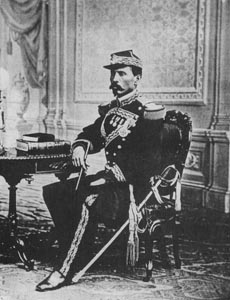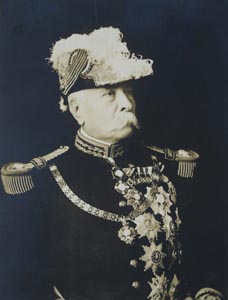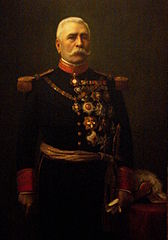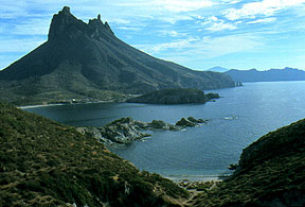In many ways, Porfirio Díaz is an enigma. Although he always gave lip service to democracy, during the thirty-five years that he controlled Mexico (1876 – 1911) he rode rough shod over freedom of speech, controlled the press, exiled dissidents and jailed opponents without trials.

His first formal education headed him toward the priesthood but an early meeting with Benito Juarez got him involved with liberal ideas and scuttled all ideas of entering the clergy. He had scant military training but his ability as an organizer led to his appointment by Juarez to a Captaincy in the forces raised by the Liberals to defend themselves against the Conservatives. Once his military career was launched, he quickly rose to high rank. Still a follower of Juarez, he was instrumental in securing the liberal victory. When the French invaded Mexico, Diaz became Commander of the Army of the East. On May 5th, 1862 he led the final charge that brought the Mexicans victory at Puebla. Cinco de Mayo, is a day still celebrated in modern Mexico. Although the French ultimately won the war and established Maximilian as Emperor, Diaz continued the struggle.
Three days after the execution of the Emperor, he led his troops into Mexico City and it was he who welcomed President Juarez when he took office for the second time. He had controlled the City and indeed the Country from June 21 to July 15, 1867. All reports indicated that he maintained order, was scrupulously honest in handling the funds available to him and repaid large loans he obtained to pay his troops. Up to this point, his public conduct was impeccable
However, his split with President Juarez was not long in coming. The new President now seemed determined to retain his office for as long as possible. He quickly abandoned the officers and men who had expelled the French, making no financial provisions to ease their return to civilian life. This was not surprising. As early as 1855 when the Liberals first took office, Juarez, a member of the new President’s cabinet, had proposed the abolition of the Army. Although the idea had been rejected, once in the Presidency, Juarez again sought to diminish the strength of the Military. There can be little doubt that he saw the Generals who had paved his way to power as potential political rivals.
At this point, Diaz resigned his commission and retired but during the next four years started to build up a political party known as the Porfirists. When Juarez sought a second term, Diaz entered the presidential race. Running against Juarez and Lerdo de Tejada he received the fewest number of votes. However, none of the candidates had a clear majority and it was the Chamber of Deputies that elected Juarez president and selected Lerdo de Tejado to serve as Vice -President and head the Supreme Court . The Porforists charged fraud and then decided that the matter should be resolved by force. Driven by personal ambition, Diaz claimed that the re-election of Juarez had violated the provisions of the Plan of Ayutla and claimed that he was seeking perpetual power. However their revolt was short lived. . But in 1871 Juarez died and was succeeded by Lerdo de Tejado.

The scene had been set for Diaz to foment a second revolt. One of the factors that led to its success was the effort of the Lerdo regime to continue to suppress the Catholic Church. In 1874 all monastic orders were expelled from Mexico. This led to the Christeros rebellion.
Despite having challenged the legality of the election of both Juarez and Lerdo de Tejado on the grounds they had not won the popular vote, Diaz declared himself de-facto President. In the struggle that ensued, the Proforists finally prevailed and 1876 he seized the Presidency by a coup d’etat. Although he retired from the Presidency in 1881, he remained the “power behind the throne.” Retired, the newly widowed Diaz, met and married Carmen Romero Rubio. Her father, Manuel Romero Rubio, was one of the founders of the Cientificos who were later to play a large part in the President’s plans. Only 19 years old, she was well educated and had lived in the U.S. Influenced and polished by her, Diaz learned to speak English, visited the U.S. and become a polished politician.
While out of office he served as Governor of Oaxaca and then as a Magistrate of the Court of Justice in Mexico City .In 1884 he was again elected to the presidency in a landslide and remained in office until 1911. During his years in power, Porfirio Díaz brought Mexico 35 years of comparative stability that brought the country into the twentieth Century. Although he had opposed the perpetuation of the presidency beyond one term, he now managed to have the Mexican Constitution amended to permit his re-election again and again. He also persuaded the legislature to extend the presidential term from four to six years.
He ruled as a Caudillo , a dictator whose will was law, yet managed to preside over a period that saw Mexico become a modern nation that welcomed foreign investment, established an infrastructure, developed railroads, provided funding for education, stabilized the currency, developed an oil industry and saw the establishment of factories. Until then, it was individual craftsmen who dominated Mexican production. By dredging harbors and improving docking facilities, Mexico was better able to develop an export business. He organized a National Police Force, the Rurales, fore-runners of the Federales, who still police the non-urban areas of the Country. His concept of power being vested in organizations rather than in individuals was indeed novel. To insure his re-election, he permitted the organization of “The Liberal Union. ” He ran for re-election as the candidate nominated by this group, thus cloaking his tight grip on power with a façade of democracy.
Willing to delegate authority to people with special skills in a specific field, in 1893 he appointed Jose Ives Limantour, a naturalized Frenchman, as Secretary of the Treasury and gave him the freedom to supervise all financial matters. The result was that by 1895 Mexico had an unprecedented surplus of 5,500,00 pesos. Although he retained his tight grip on political power, he was willing to work with a group who labeled themselves Cientificos. They had started as a political party, but later became technocrats. The group sought personal wealth rather than political power. In doing so, they aided the Dictator to spread industrial development throughout the urban areas of the country. However, they were firm believers that wealth would trickle down. To a certain extent it did and a middle class emerged. But the downside of this was that they perceived the indigenous population and the mostly uneducated farmers as being totally unprepared to participate in a democracy. Additionally, upper and middle class women were encouraged to remain homemakers. Only women in the lower classes were employed in factories and as maids or worked in retail establishments and helped on the farms.
The development of the urban areas of the country increased the gap between rich and poor. The industrialization was largely in the hands of foreign investors. It left behind the vast numbers in rural areas.
These inequalities still exist today.

Viewed as a “Benevolent Dictator” by the U.S. Government, many of the rifts that had divided the two countries were patched over. U.S. Secretary of State Elihu Root called Diaz “the indispensable Caudillo” and referred to him as “El Supremo.” Perhaps the secret of his success was the ability of Diaz to enjoy the support of the new industrialists and the new middle class. Powerful foreign corporations were now in place in the country. Given preferential treatment, they threw their support to the Dictator. As time went by he gained control over almost all elected officials. Governors of States and Mayors of cities were all hand picked. At the same time, he ignored the laws that placed restrictions on the Catholic Church. He did not attempt to remove the legal restrictions incorporated in the original Lerdo Laws, but simply ignored them.
Those laws are still in force today but are seldom enforced. During the Diaz Presidency the Catholic Church re-established itself. Religious orders were re-organized. In 1910 the banners of the The Virgin of Guadalupe were paraded for the first time since 1860. There can be no doubt that the re-emergence of the church contributed to the stability of the country
While the Porfirio Díaz era prevented the emergence of a truly democratic government in Mexico, viewed from the point of view of the conditions that prevailed before he assumed office it is only fair to say that he did end an era of chaos and must be given credit for laying the foundations that made the Mexico of today. But this long period of one-man control left its mark on the country that has only been broken in the last two Presidential elections. The legacy of one man rule, transformed itself into one party control of the political scene and survived for some 70 years in the person of the P.R I..
The end of the Diaz regime began in March of 1908, when James Creelman, an American Journalist, interviewed President Diaz. In the interview Diaz again declared his complete confidence in democracy. It was this interview that ultimately led to the Caudillo’s downfall by encouraging the development of political parties. He excused his long retention of the Presidency by saying that he came into office at a time when Mexico was not ready for democratic institutions. There is some merit to his claim. He then went on to say that he now believed that Mexico was prepared to select and change its government regularly without danger of civil war or damage to its national progress. During his presidency, Diaz had permitted Limantour to cut back the size of the Mexican Army. Thus, when Francisco I. Madero finally launched a campaign against the regime that developed into an armed insurrection, the Mexican Army was too weak to resist and Diaz resigned and moved to Paris. He died there in 1915 and his remains are still in the cemetery of Montparnasse.
The Dictator was wrong in his assessment of the stability of the political situation. From 1911 when he left office until almost 1929 the country was torn by revolution. In 1913 President Madero who had succeeded Diaz was forced out of office and murdered. The country remained in chaos. It was not until 1929 that the P.R.I. was formed and an “election” albeit rigged, replaced the gun as the road to the Presidential Palace. There are few monuments to Porfirio Díaz in modern day Mexico. He was not mourned when he left office and is not a popular hero now but his legacy both good and bad still lives on.

